Tetranychus urticae
Contents
- Top Tips & Info
- Symptoms
- Susceptible Plants & Parts
- Actions Needed (Includes pros & cons of Chemical or Organic based pesticides)
- Ways to Prevent an Attack in the Future
Need the answer to a specific plant or pest query? Book a 1-to-1 video call with THE HOUSEPLANT DOCTOR™, the website's friendly author, to overcome and address your niggling problem! Available on iMessage, WhatsApp, Facebook Messenger & more.
Top Tips & Info
- Eradication Difficulty - Difficult
- Life Cycle - Up to fifty-five days.
- The female can lay up to twenty eggs per day - one hundred & fifty in total.
- Webs & Colonies will develop in cubbyholes, under-leafs and flowers.
- Juvenile Spider Mites have six legs when hatched & will develop a final pair once matured, giving them eight legs when ready to reproduce.
- Remove and crush all of the visible mites and webs using your fingers or a cloth.
- Prune off the severely affected leaves and any flowers that house the infestation.
- Take the plant outside and perform a gentle hose-down - aim at all of the cubbyholes and under-leaves for complete obliteration.
- Allow the plant to dry off before applying either an organic or chemical-based pesticide (Predatory Mites like Andermatt's Phytoseiulus or 'SMC Control' etc).
- Repeat the wiping, hosing-down and pesticide steps every 7 - 14 days for the next month, in this order. Keep the plant at least 1m away from others to avoid spreading the infestation.
- Entirely eradicating the mites will be a long and challenging process to fulfil, but is still successful if you follow these top tips!
What are the Symptoms of Spider Mites on Houseplants?
At first, unless you specifically look for them, they'll go unnoticed due to their translucent minute bodies hiding in creases of the under-leaves. After a while, small clusters of webs will develop in these areas, trapping tiny bits of dirt or compost. Small transparent 'blotches' and mottled yellow leaves are other key symptoms to look out for. They'll spread onto the remaining parts of the leaves, or even onto other nearby plants, so action must be taken quickly.
 Here is an example of what Spider Mites look like on a houseplant. Here, you can see the small intricate webs that have formed along the leaf's midrib.
Here is an example of what Spider Mites look like on a houseplant. Here, you can see the small intricate webs that have formed along the leaf's midrib.
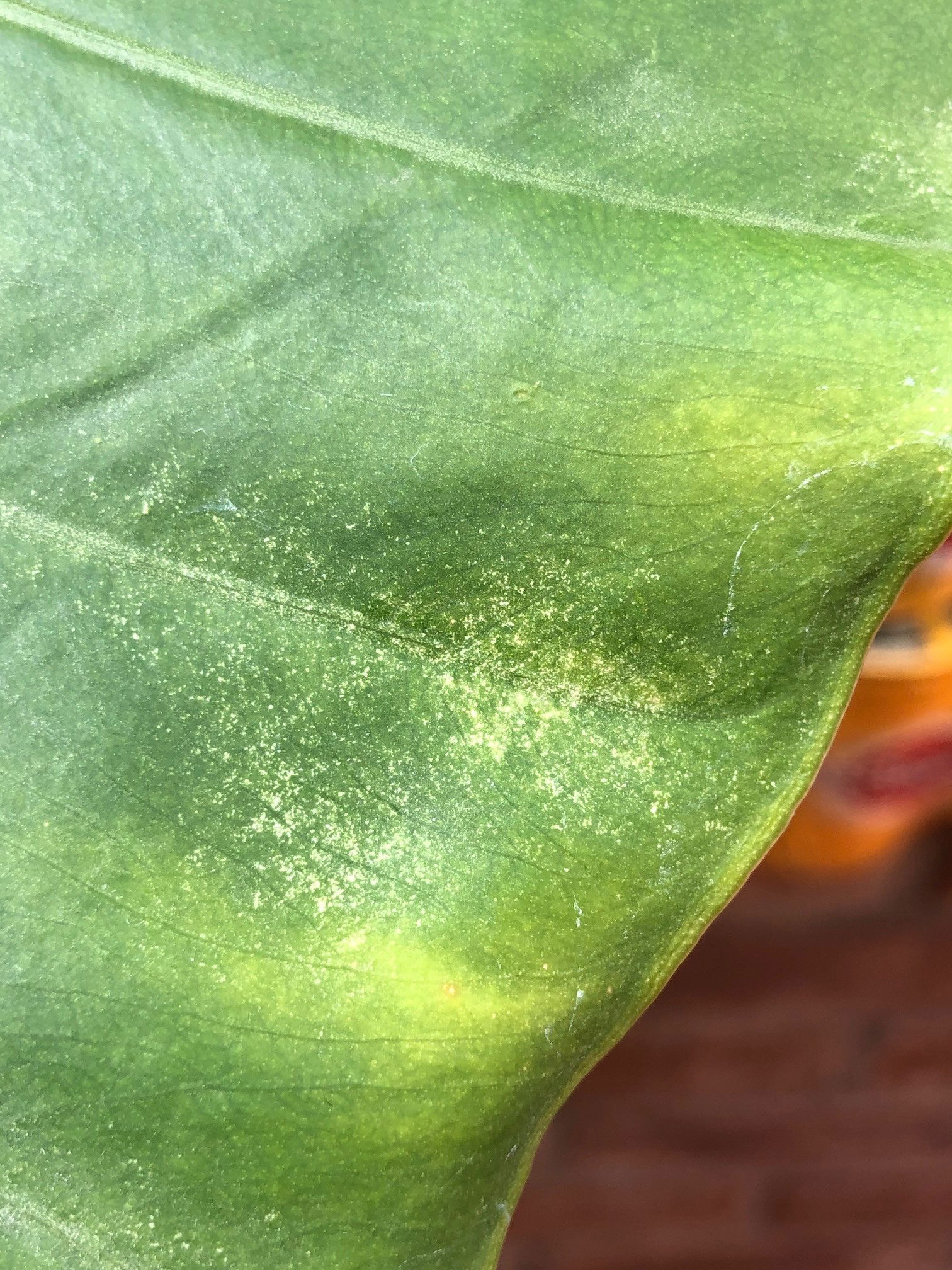 Here is the typical damage of Spider Mites.
Here is the typical damage of Spider Mites.
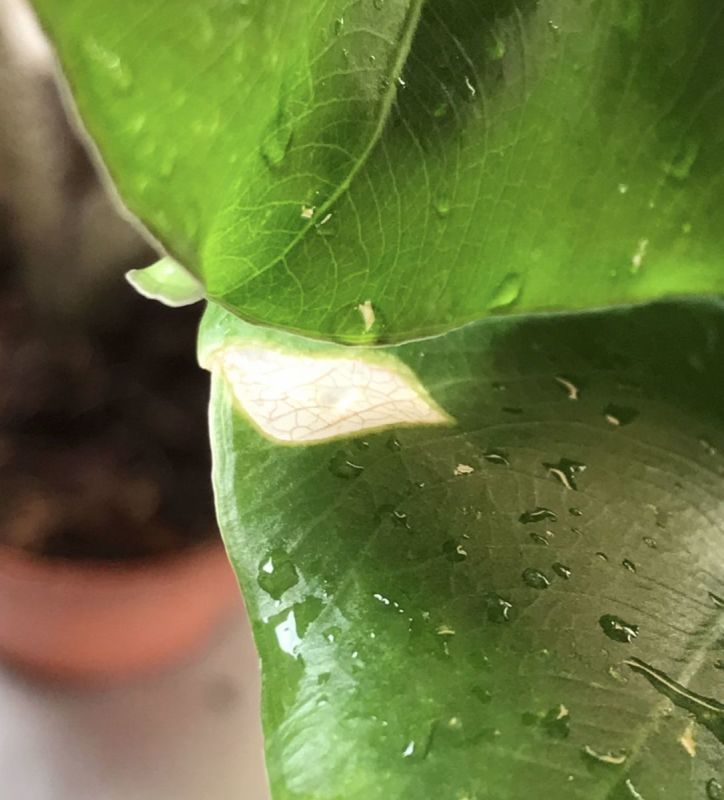 In some cases, an infestation may leave small translucent spots across the host's foliage.
In some cases, an infestation may leave small translucent spots across the host's foliage.
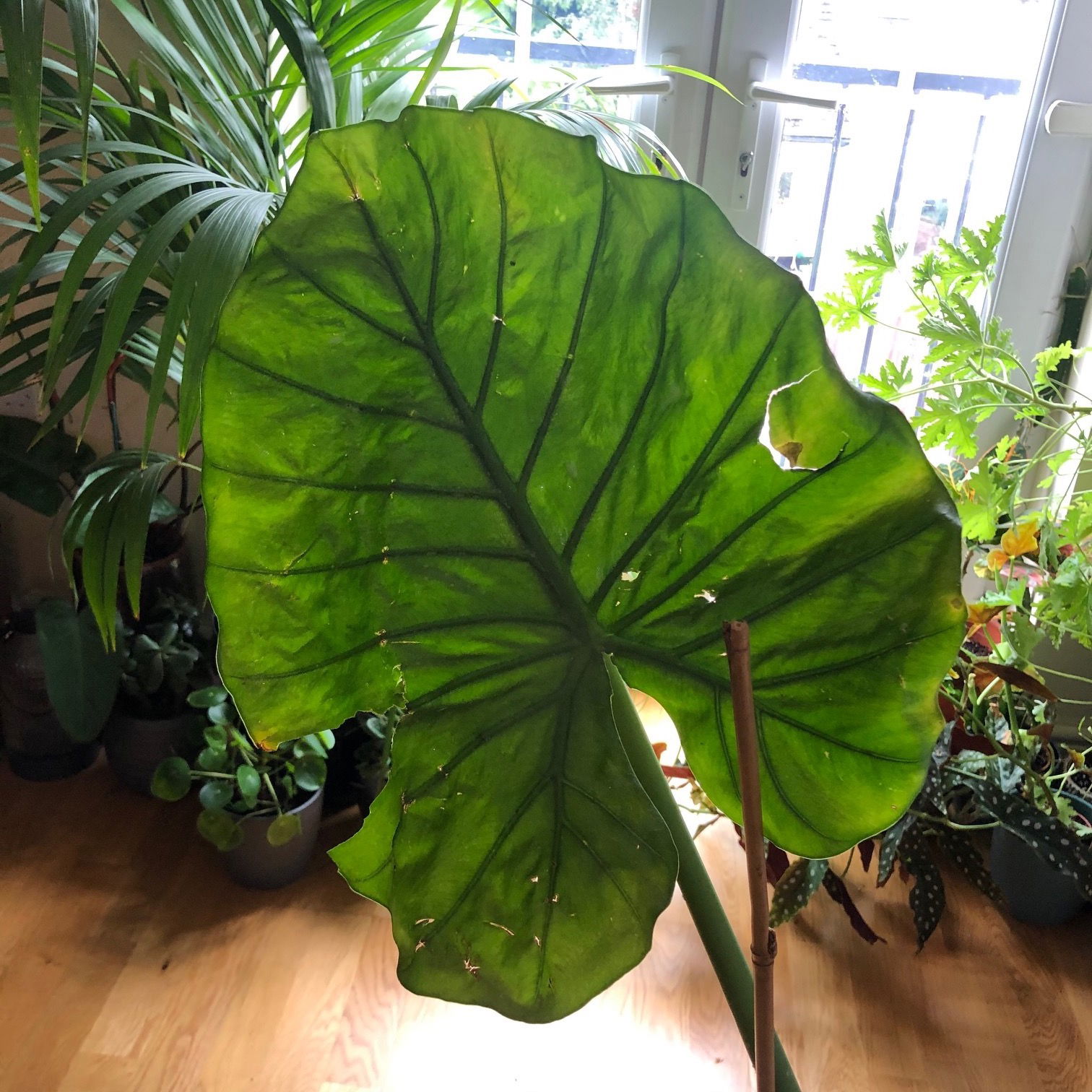 The final symptom of an infestation is darkened midribs when inspected through bright light, compared to the leaf itself. The Mites are actually causing the main leaf to loose its colour, thus resulting in a larger contrast.
The final symptom of an infestation is darkened midribs when inspected through bright light, compared to the leaf itself. The Mites are actually causing the main leaf to loose its colour, thus resulting in a larger contrast.
What are the most Susceptible Houseplants & Where do Spider Mites live on them?
Along the midribs (the central column that supports and nourishes the leaf). Webs can develop in the creases of the under-leaves, to protect themselves from drying out by the direct sunlight. In more severe cases, they'll infest the flowers or the junction between the leaves and stems.
Plants - All species are susceptible to Spider Mites, especially with those who have thin, broad leaves like Aroids, Banana Palms, Calathea & Umbrella Trees.
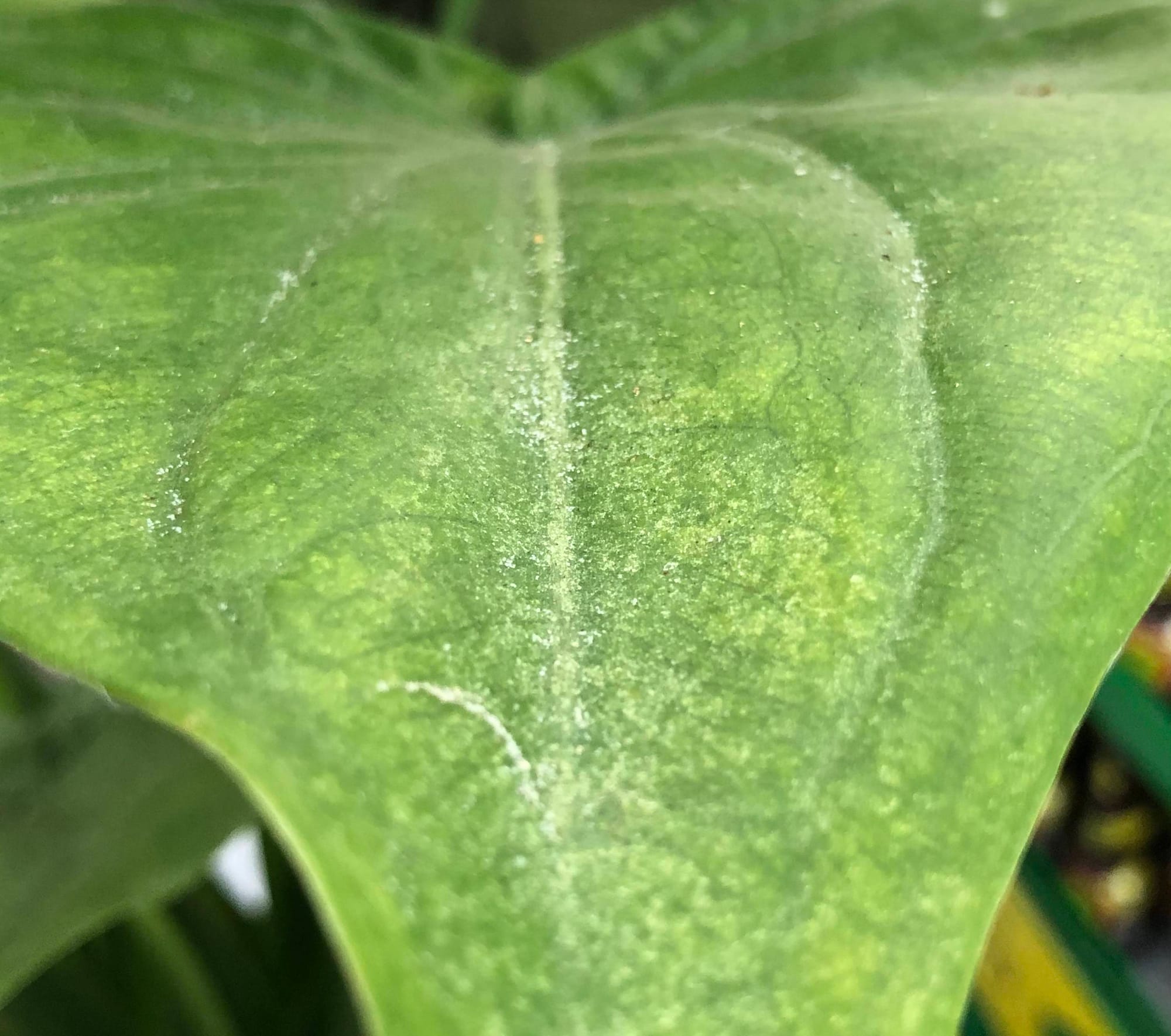 Another example of the damage caused by Spider Mites on houseplants. Have a closer look to see their webs slowly engulf this poor Alocasia cucullata's leaf.
Another example of the damage caused by Spider Mites on houseplants. Have a closer look to see their webs slowly engulf this poor Alocasia cucullata's leaf.
What are the Actions Required to Eradicate Spider Mites from Houseplants?
1. While using a damp cloth, destroy as much of the mites and their webs as possible. Any flowers must be removed along with the severely affected leaves or stems. Rub the cloth wholly across both sides of the leaves, focusing your attention to the under-leaves where the webs and eggs will lay.
2. Take the plant outside, GENTLY washing the entire plant using an outdoor hose. It's important to spray in at least three different angles to ensure thorough administration. Empathise the cubbyholes, under-leaves and between the stem and its petioles.
3. Repeat the first two steps twice a week for a month and decide if you're going to use a pesticide to help destroy the infestation. There are two options to choose from - organic or chemical-based pesticide.
4. Keep the affected plant away from others in a quarantined room until the symptoms have subsided for at least eight weeks. Always be wary of a relapse, and keep an eye out for possible outbreaks for several months after the last sighting.
Extra Tip: Although you should perform the wiping and hosing-down process BEFORE each pesticide application, you can wash the foliage at any given time to keep the infestation under control.
Organic Pesticides
Predatory Mites - Releasing Predatory Mites on your affected houseplant's foliage is a more natural approach to controlling the infestation. THE HOUSEPLANT DOCTOR™ recommends using Andermatt's predatory Spider Mite Killers which gets to work within a few hours of application. As these are near-invisible mites that'll feed off the Spider Mites, you won't need to spend money or time using chemical pesticides. Click on the link to buy it and use our code 'JOE15' for 15% off!
'Cinnamite' is a non-toxic pesticide derived from cinnamon oil, which should kill juvenile and adult mites, but NOT the eggs. After another quick hose-down, repeat applications every three days over two weeks, to ensure newly hatched eggs are destroyed.
Rosemary Oil is a lesser-known pesticide that works wonders. Snip several sections of rosemary and bring to the boil for total infusion. Once the temperature is manageable for the plants, spray both sides of the leaves and repeat weekly. In the meantime, keep affected plants at least 50cm away from other specimens to avoid the infestation spreading. This method is also excellent for edible plants dues to the absence of chemicals.
Herbal Tea - Again, like rosemary water, drop a herbal teabag into the water and bring to the boil. Then, add crushed fresh garlic to the water, allowing it to stand until lukewarm. Spray both sides of the leaves and repeat weekly after a hose-down to keep the population down.
Insecticidal or Horticultural Soap is another popular organic pesticide on the market, and there are two versions to consider. The first way is by purchasing an RTU (ready-to-use) spray bottle, which can be immediately used on the plants. Although most garden centres will stock this, it's far more economical to purchase the second option - concentrated bottles. This method comes with pro's and con's but is far cheaper to use if you have multiple infestations. It's self-explanatory and highly beneficial for the outbreak as long as you use the correct levels of dilution - the only downside is its availability in local centres. It's best to buy this option online as there are many different companies to choose from, with some being cheaper than others.
Natural Predators - The last non-organic method is by acquiring adult ladybirds or green lacewings. Although buying insects may be deemed as cruel or inappropriate, it's a natural, and least time-consuming way to remove the pests. Many online stores will sell the insects, all at varying prices and quantities. Once you've obtained the predators, release them in different sections of the plant, favouring the most infested areas first. They'll make their way around your plant, digesting both the eggs and the adults, leaving you with a potentially pest-free plant. Keep the insects and plant in an enclosed transparent box throughout this period to increase the rate of digestion. Unfortunately, this method can take several days, if not weeks, to work and could even be unsuccessful, which is why other methods are favoured.
Chemical Pesticides
Most chemical pesticides are bought either as an RTU (ready to use) spray or in a concentrated bottle. Of course, it's far more economical to buy the latter as it'll last longer with multiple infestations, but RTU sprayers are still great for small issues. Both of these methods can be purchased at most garden centres, costing from £3 for RTU sprayers, up to £7 for the concentrated variety. Chemical-based pesticides should only be used as a last-resort measure due to the risk of affecting other biodiversity.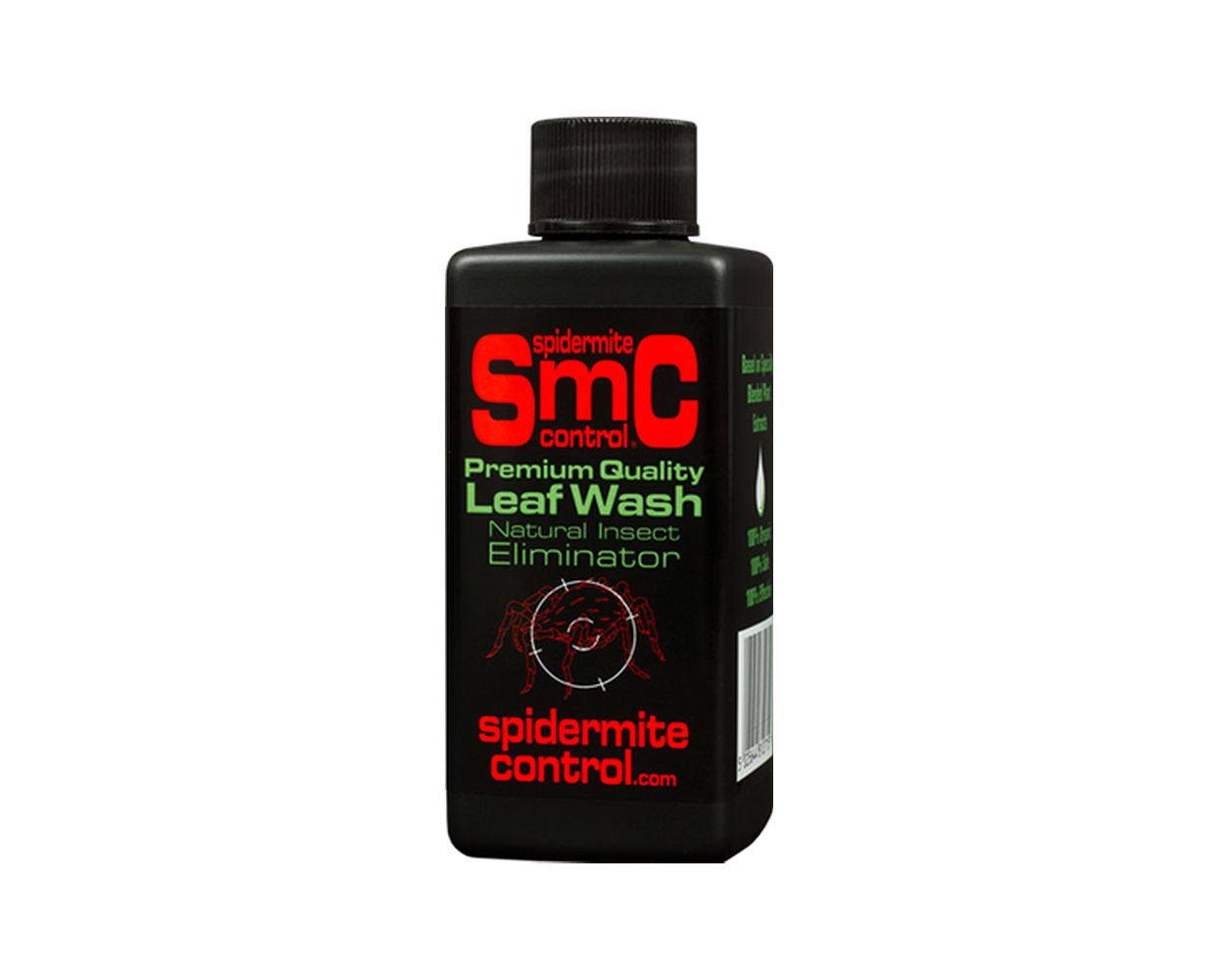 Try out 'SMC Control' for issues of Spider Mite infestations!
Try out 'SMC Control' for issues of Spider Mite infestations!
SMC Control - This product gets to work after the first application. It's a concentrated product, meaning that you'll have to dilute it with the appropriate amount of water. Spray both sides of the leaves, along with any cubbyholes that could house the infestation. Keep the plant away from other specimens once there are no signs of an outbreak for over a month. Chemical-based pesticides should only be used as a last-resort measure due to the risk of affecting other biodiversity. SMC Control will leave a slightly sticky residue on the foliage, but this can be washed off with a cloth of soapy warm water.
Rubbing Alcohol - If you're looking for something with even more strength, try an Isopropyl Rubbing Alcohol, which can be bought from many online stores. This pesticide will work immediately, killing the bugs within a few hours of contact. Follow the manufacturer's recommendations and repeat hosing the plant down and pesticide application steps fortnightly until the infestation has elapsed. Keep it well away from others until the plant is deemed safe.
What are the Ways to Prevent a Spider Mite Attack in the Future?
1. When buying a new plant from a local plant shop or garden centre, check around the common areas for infestations like its leaves, stems and flowers. Most Spider Mite issues come from already-affected plants, so always keep this in mind when increasing your plant-collection!
2. Change the top layer of the soil when bringing any new plant from a shop. Replacing the top layer of the compost will remove any larvae that may have fallen in, or been deposited by a pest. THE HOUSEPLANT DOCTOR™ does this religiously whenever a new plant enters the house!
3. Perform monthly checks for pests on your own plants. Although this may sound patronising, many gardeners forget to inspect their indoor specimens and that's exactly when an infestation can arise.
Book a 1-to-1 Consultation with THE HOUSEPLANT DOCTOR™
Need realtime advice for your Spider Mite infestation? Book a video or message consultation with expert Joe Bagley, THE HOUSEPLANT DOCTOR™ (author or ukhouseplants.com). Choose between a ten or thirty-minute session & a platform of your choice (WhatsApp, FaceTime, Facebook Messenger or Zoom). Ask unlimited questions in one session, including queries on your dying/challenging plants, pests eradication, terrariums, repotting advice & everything in between! Available worldwide.